As long as they were active, pirates were one of the favorite topics in the press. Reports on trials and execution of death sentences ensured the demand for newspapers and leaflets. Rather unintentionally, these publications created a rather seductive image of sea robbers - false, not reflecting the grim reality.
Recently, the "golden age" in the history of pirates is called the years 1700–1730, or even a shorter period. The shipping historian David Cordingly begins in 1698, when Captain Kidd, a corporal turned pirate, seized the Quedah Merchant, and at the end of 1722, when the remnants of Bart Roberts' crew were hanged in a mass execution at Cape Coast Castle in West Africa .
In my Edward Teach Blackbeard biography: America's Most Notorious Pirate (2006) propose an even narrower time frame:1714–1725. We all use, of course, subjective criteria when expressing our views on this matter. No one doubts that piracy in the waters of the Americas, Africa and the Indian Ocean increased in the first decades of the 18th century. "Golden Age of Piracy" is a handy symbolic term to describe this phenomenon.
A product of European politics
At that time, this phrase was never used - neither in newspapers, nor in court records, other documents or letters. It was most likely introduced after the "golden age" had passed. Widely used by historians today, it is not a modern invention. Its creator is the British Rafael Sabatini (1875–1950), the author of the adventure novels Captain Blood (Captain Blood, 1922) and Black Swan ( The Black Swan , 1932), adapted by Hollywood.
Regardless of the origin and ironic overtones, the expression helps to indicate the phenomenon. Pirates and their victims were, in a way, a product of the policies of European countries. We know how the buccaneers were gradually brought under government control.

The image of pirates fixed in the public consciousness is far from reality
In the 1770s, attacks on the Spaniards became unacceptable, except during the war. England held its buccaneers strong after Morgan's invasion of Panama City (1670–1671); he himself was involved in legislative initiatives to prevent illegal expeditions . France took longer to restore order, but it did before the end of the century. When the Spanish Succession War broke out (1701–1714), all maritime powers rationalized the way their privateers operated - forced them to obey the law.
In this conflict, the American segment of which is known as Queen Anne's War, France clashed with the three powers. She had numerous and active corporers in the Caribbean, as did England (after 1707, Great Britain), unlike the Netherlands and Spain.
In Europe, the marinas for captains holding the relevant patents have become, above all, the French Dunkerque and the English Bristol, in the New World Fort-de-France in Martinique, Bridgetown in Barbados, Petit-Goâve on Saint-Dominique and Port Royal in Jamaica.
At that time, kaperery brought great income. There were crowds of seafarers who saw the opportunity to enrich themselves in the ports mentioned. Port Royal was booming again, everyone making money except the owners losing their ships. Finally, the fighting fervor of the great powers began to wear off, the British government initiated confidential talks with the French in 1711. They led to the signing of the Treaty of Utrecht in April 1713, ending hostile actions between the states dominating in the waters.
New Plague
Peace revealed the fullness of the problem that Britain had procured for itself. With the cessation of fighting, all private letters expired immediately, and six thousand sailors using them were left without occupation. They filled the ports in search of work. Some succeeded as the British merchant navy grew rapidly after the end of the war. The number of ships increased, and hence the need for crews.
The former privateers welcomed the meager conditions offered them, and I pay the same. Others intended to use what they learned while ignoring peace. They chose to pirate but tried to hide it, maintaining the fiction of legality :They robbed only former French and Spanish enemies. Still others, like Blackbeard and Bartholomew Roberts, had no such scruples.
All this meant that after the end of the war, the British side had both pirates and potential victims, including North American merchant ships. The Caribbean and America's Atlantic coast were most at risk, but the new plague spread widely, spreading to West Africa and the Indian Ocean.

The text is an excerpt from Angus Konstam's book “Świat piratów. The history of the most dangerous sea robbers ”, which has just been released by the Bellona publishing house.
There, the sea robbers were at their best. Unlike the seventeenth-century bookers, they did not group themselves into large fleets, and at the same time went beyond the Caribbean Sea. They had a noticeable impact on international economic exchange, which was reflected in the increase in insurance rates. They were favored by the absence of the state. Piracy always develops in areas where governments lack the strength or will to deal with the problem . The weakness of the authorities of most of the then American colonies made it possible to make the Atlantic coast an attractive hunting ground, at least temporarily, until decisive countermeasures were taken.
Often such contractions occurred when disruptions to water transport and increased insurance premiums resulted in more losses than the covert trade of colonists with pirates brought benefits. The "golden age" was coming to an end as pirates were located and eliminated one by one. Demonstration executions probably discouraged sea people from a criminal career. By 1730 at the latest, this era ended (…).
Pirate haven
In the "golden age", some of the world's most famous pirates raged. The romantic stories repeated over the years make us see them bigger than they really were. The term "golden age of piracy" is misleading. He suggests that it should be a time of romantic heroes, not of cruel robberies and economic perturbations. Writing developed long after the end of the epoch sometimes strayes far from the truth.
A significant difficulty in practicing pirate crafts was the fact that the trophies did not usually come in the form of coins easily divisible among the crew. The victims were mostly small merchant ships, brigs and sloops. Even fishermen around Newfoundland were at risk of attack. Larger units could transport slaves from West Africa to Jamaica, rum and sugar from the Caribbean to Europe or North American colonies, products from British manufactories to those colonies, or tobacco, cotton, wood and clothing in the opposite direction.
In general, conquerors simply drank rum, and smashed other charges more than once in an unbridled frenzy of destruction. Like all criminals, in order to get live cash, they needed someone to buy the misappropriated goods. Most ports were inaccessible to them due to a growing aversion to piracy and illegal trade. Small settlements and islands remained. Of course, they would love to see a homely town with dark-business traders, brothels, taverns, and shackles. And they got it.

The most famous pirates prowled the Caribbean Sea
The pirate harbor on the island of New Providence in the Bahamas was born out of an unlucky event for the Spaniards:on June 30, 1715, the annual treasure convoy headed to Europe, heading north through the Old Bahamian Channel between Florida and the Greater Bahamas. The growing wind turned into a hurricane in the evening. Eleven ships crashed on the shores of Florida, and in the morning only one was afloat. He quickly turned back to Havana, the governor of which immediately sent an expedition for the survivors and the silver.
Others have also reached for the ore. At the end of November, three hundred attackers attacked the camp where the recovered treasure was kept. They took it after driving out the few guards. Former privateers from Port Royal acquired at least 60,000 reales de a ocho. For many, the days gone by have come alive.
Silver rush
A few weeks earlier, the governor of Jamaica had sent Corporal Henry Jennings to the shores of Florida to see if there was anything left to save. The twisted person took it as consent to robbery. He visited Florida again in January of the following year, and in similar circumstances took away 120,000 coins. There were no further repetitions, as the valuables were transferred to a well-armed fortress, and in the summer two galleons took them to Spain.
The treasury was deserted. Still, nearly a quarter of a million eight-dolls were littered among the wrecks. The Caribbean is under a silver rush. Captain Jennings and a crowd of volunteers did not hesitate to inspect the remains of the treasure fleet. They were doing this on Spanish territory, so the Jamaican administration, succumbing to diplomatic pressure, renounced the collectors.
They lost their ability to spend money in Port Royal, but they had an alternative. In early 1716, a handful of Jamaican black market traders moved into a poor British colony in New Providence in the Bahamas. They eagerly traded the stolen goods, so Jennings and his ilk became their contractors. By summer, the estate had grown into a populous den for pirates, treasure hunters and smugglers - a hub for illegal trade. In June, the governor of Virginia, in a letter to London, complained that pirates had taken possession of the Bahamas. So the new socket was well made.

As long as they were in operation, pirates were one of the favorite topics in the press.
New Providence had nothing but advantages:proximity to important shipping lanes and wrecks in Florida, favorable winds for reaching hunting zones. The natural harbor near Nassau was large enough to accommodate a hundred or more vessels.
There was plenty of food, water and wood on the island, and convenient vantage points, even a small fort built by the original colonists who were now a minority. First of all, there was a shanty town there to meet all the needs of pirates . A land of about 97 square kilometers was barely suitable for decent settlement. While New Providence was nominally a British colony and the capital of the British Bahamas, it had no governor to impose the authority of the crown. So nothing prevented the pirates from taking the island for themselves.
The end of the "golden age"
There are data that in the summer of 1717 over five hundred pirates used the island as a base; they sailed on at least a dozen small ships. In good years that were short-lived, it hosted Benjamin Hornigold, Charles Vane, Henry Jennings, Calico Jack Rackam, Edward Teach (Blackbeard), Sam Bellamy and quite a few others.
Merchants traded with them, then smuggled the acquired goods into the more venerable markets of North and Central America. Captured ships were bought and sold elsewhere. Boatbuilders made money by repairing ships and captured ships, blacksmiths - repairing cannons and all weapons. Life must have been lively and colorful where the only form of government was the collective will of the chief captains.
Until the end has come. Complaints about pirates were heard even in London, and it was decided to do something about the problem. On September 5, 1717, King George I signed the relevant document, "Announcement on the Suppression of Piracy." According to it, if they surrendered within a year, they would be forgiven for all crimes committed by the following December, not later. Those who refuse grace will be hunted. The classic carrot and stick policy based on the notion that people will change for the better when given a second chance.
A copy of the announcement was delivered to New Providence in December. Two parties were formed. The first, headed by Hornigold and Jennings, were in favor of accepting the proposal. The "Intransigent", centered around Charles Vane, did not agree to any capitulation.
Source:
The text is an excerpt from Angus Konstam's book “Świat piratów. The history of the most dangerous sea robbers ”, which has just been released by the Bellona publishing house.
